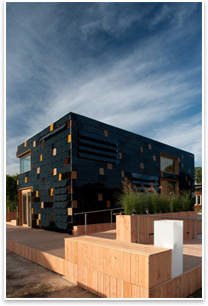
Team Germany’s winning house is a two-story cube shape that provides maximum dimensions and surface area for the photovoltaic panels that cover its entire façade. The team estimated that this solar energy system would produce twice as much energy as the house required. The house also features automated louver-covered windows and a boiler integrated into the heat pump system that allows the system to provide domestic hot water as well as heating and cooling.
For the second competition in a row, the German team from Technische Universität Darmstadt won the U. S. Department of Energy Solar Decathlon. The German team edged out Team California (from Santa Clara University, California College of the Arts), which had won the individual architecture and communications competitions, but ultimately took third place. Team Illinois, from the University of Illinois at Urbana-Champaign, came in second. The German team had a perfect score in the net metering competition, which measures house’s ability to sell energy back to the grid.
Read previous AIArchitect stories about the 2009 Solar Decathlon from October 16 and October 9. |


